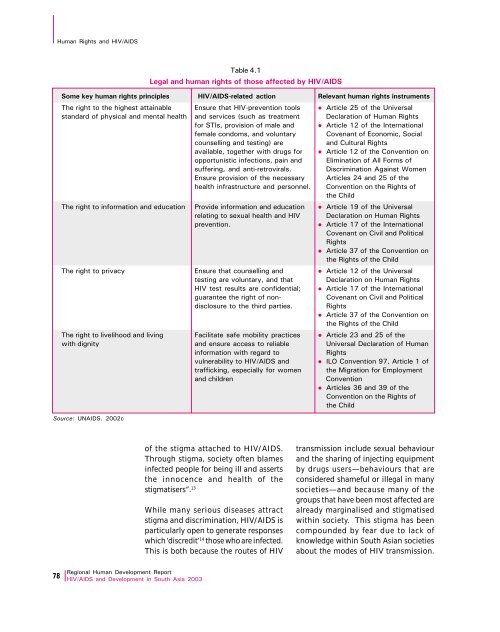Download Report - UNDP Asia-Pacific Regional Centre - United ...
Download Report - UNDP Asia-Pacific Regional Centre - United ...
Download Report - UNDP Asia-Pacific Regional Centre - United ...
You also want an ePaper? Increase the reach of your titles
YUMPU automatically turns print PDFs into web optimized ePapers that Google loves.
Human Rights and HIV/AIDSSource: UNAIDS. 2002cTable 4.1Legal and human rights of those affected by HIV/AIDSSome key human rights principles HIV/AIDS-related action Relevant human rights instrumentsThe right to the highest attainable Ensure that HIV-prevention tools l Article 25 of the Universalstandard of physical and mental health and services (such as treatment Declaration of Human Rightsfor STIs, provision of male and l Article 12 of the Internationalfemale condoms, and voluntary Covenant of Economic, Socialcounselling and testing) areand Cultural Rightsavailable, together with drugs for l Article 12 of the Convention onopportunistic infections, pain and Elimination of All orms ofsuffering, and anti-retrovirals. Discrimination Against WomenEnsure provision of the necessary Articles 24 and 25 of thehealth infrastructure and personnel. Convention on the Rights ofthe ChildThe right to information and education Provide information and education l Article 19 of the Universalrelating to sexual health and HIV Declaration on Human Rightsprevention. l Article 17 of the InternationalCovenant on Civil and PoliticalRightsl Article 37 of the Convention onthe Rights of the ChildThe right to privacy Ensure that counselling and l Article 12 of the Universaltesting are voluntary, and that Declaration on Human RightsHIV test results are confidential; l Article 17 of the Internationalguarantee the right of non-Covenant on Civil and Politicaldisclosure to the third parties. Rightsl Article 37 of the Convention onthe Rights of the ChildThe right to livelihood and living acilitate safe mobility practices l Article 23 and 25 of thewith dignity and ensure access to reliable Universal Declaration of Humaninformation with regard toRightsvulnerability to HIV/AIDS and l ILO Convention 97, Article 1 oftrafficking, especially for women the Migration for Employmentand childrenConventionl Articles 36 and 39 of theConvention on the Rights ofthe Childof the stigma attached to HIV/AIDS.Through stigma, society often blamesinfected people for being ill and assertsthe innocence and health of thestigmatisers”. 13While many serious diseases attractstigma and discrimination, HIV/AIDS isparticularly open to generate responseswhich ‘discredit’ 14 those who are infected.This is both because the routes of HIVtransmission include sexual behaviourand the sharing of injecting equipmentby drugs users—behaviours that areconsidered shameful or illegal in manysocieties—and because many of thegroups that have been most affected arealready marginalised and stigmatisedwithin society. This stigma has beencompounded by fear due to lack ofknowledge within South <strong>Asia</strong>n societiesabout the modes of HIV transmission.78<strong>Regional</strong> Human Development <strong>Report</strong>HIV/AIDS and Development in South <strong>Asia</strong> 2003
















